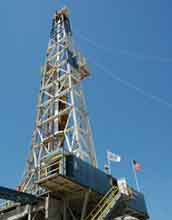Media Advisory 04-25
Geologists Host Tour Of San Andreas Fault On Sept. 2nd
EarthScope Project Scientists Lead Modern-Day 'Journey to the Center of the Earth'
August 9, 2004
This material is available primarily for archival purposes. Telephone numbers or other contact information may be out of date; please see current contact information at media contacts.
In a modern-day journey to the center of the Earth, geologists are exploring the structure and evolution of the North American continent at scales from hundreds of kilometers to less than a millimeter - from the structure of a continent, to individual faults, earthquakes and volcanoes. The project is called EarthScope. With approximately $200 million in funding from the National Science Foundation (NSF), EarthScope will be developed over the next five years. The project is expected to operate for an additional 15 years.
On Sept. 2, scientists studying San Andreas Fault geology will provide a first look at the multiple technologies EarthScope will use to explore the structure and tectonics of North America:
- A four-kilometer deep observatory drilled directly into the San Andreas fault to measure the physical conditions under which earthquakes there occur
- One of 875 permanent Global Positioning System (GPS) stations being installed, which can measure relative distance changes of less than 0.5 millimeters
- One of an eventual network of 400 seismographic stations that will spread across the United States, making observations at more than 2,000 geographic locations to map the structure and composition of North America
- The unique educational opportunities that EarthScope will provide as a national experiment, its sensors located at more than 3,000 sites across the United States to measure and observe plate tectonics in real time
|
Who: |
Scientists from NSF, the U.S. Geological Survey, and the EarthScope Project: |
|
What: |
EarthScope's first look into North American continent geology |
|
When: |
Thursday, Sept. 2 |
|
Where: |
San Andreas Fault |
-NSF-
For more information on the EarthScope Project, please see: www.earthscope.org
Media Contacts
Cheryl L. Dybas, NSF, (703) 292-7734, email: cdybas@nsf.gov
Related Websites
EarthScope Project: http://www.earthscope.org
The U.S. National Science Foundation propels the nation forward by advancing fundamental research in all fields of science and engineering. NSF supports research and people by providing facilities, instruments and funding to support their ingenuity and sustain the U.S. as a global leader in research and innovation. With a fiscal year 2023 budget of $9.5 billion, NSF funds reach all 50 states through grants to nearly 2,000 colleges, universities and institutions. Each year, NSF receives more than 40,000 competitive proposals and makes about 11,000 new awards. Those awards include support for cooperative research with industry, Arctic and Antarctic research and operations, and U.S. participation in international scientific efforts.
Connect with us online
NSF website: nsf.gov
NSF News: nsf.gov/news
For News Media: nsf.gov/news/newsroom
Statistics: nsf.gov/statistics/
Awards database: nsf.gov/awardsearch/
Follow us on social
Twitter: twitter.com/NSF
Facebook: facebook.com/US.NSF
Instagram: instagram.com/nsfgov



